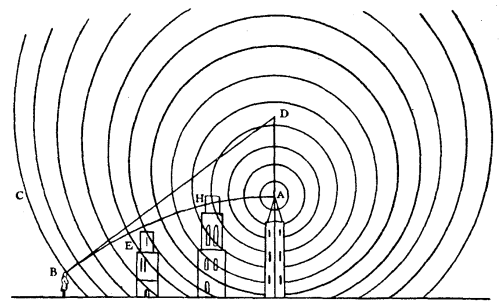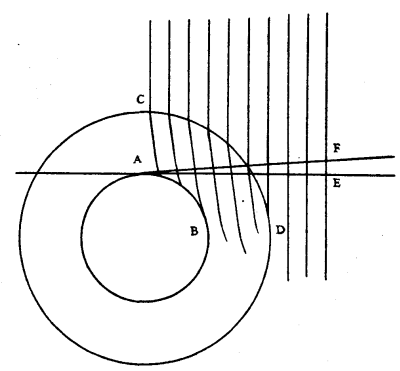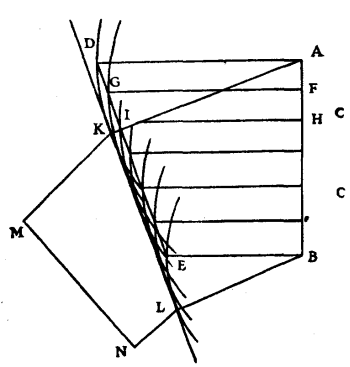Refraction Of The Air
Table of Contents
The movement which constitutes light spreads by spherical waves in any homogeneous matter.
When the matter is not homogeneous, these waves cannot be spherical
They must acquire their shape according to the different distances over which the successive movement passes in equal times.
I shall explain the refractions which occur in the air, which extends to the clouds and beyond.
Refractions are seen when we islands and mountaintops from the sea.
Because also of them the Sun and the Moon appear as risen before in fact they have, and appear to set later: so that at times the Moon has been seen eclipsed while the Sun appeared still above the horizon. And so also the heights of the Sun and of the Moon, and those of all the Stars always appear a little greater than they are in reality, because of these same refractions, as Astronomers know.
But there is one experiment which renders this refraction very evident; which is that of fixing a telescope on some spot so that it views an object, such as a steeple or a house, at a distance of half a league or more.
If then you look through it at different hours of the day, leaving it always fixed in the same way, you will see that the same spots of the object will not always appear at the middle of the aperture of the telescope, but that generally in the morning and in the evening, when there are more vapours near the Earth, these objects seem to rise higher, so that the half or more of them will no longer be visible; and so that they seem lower toward mid-day when these vapours are dissipated.
Those who consider refraction to occur only in the surfaces which separate transparent bodies of different nature, would find it difficult to give a reason for all that I have just related; but according to our Theory the thing is quite easy.
It is known that the air which surrounds us, besides the particles which are proper to it and which float in the ethereal matter as has been explained, is full also of particles of water which are raised by the action of heat; and it has been ascertained further by some very definite experiments that as one mounts up higher the density of air diminishes in proportion.
Now whether the particles of water and those of air take part, by means of the particles of ethereal matter, in the movement which constitutes light, but have a less prompt recoil than these, or whether the encounter and hindrance which these particles of air and water offer to the propagation of movement of the ethereal progress, retard the progression, it follows that both kinds of particles flying amidst the ethereal particles, must render the air, from a great height down to the Earth, gradually less easy for the spreading of the waves of light.

Whence the configuration of the waves ought to become nearly such as this figure represents: namely, if A is a light, or the visible point of a steeple, the waves which start from it ought to spread more widely upwards and less widely downwards, but in other directions more or less as they approximate to these two extremes. This being so, it necessarily follows that every line intersecting one of these waves at right angles will pass above the point A, always excepting the one line which is perpendicular to the horizon.[Pg 48]

Let BC be the wave which brings the light to the spectator who is at B, and let BD be the straight line which intersects this wave at right angles.
Now because the ray or straight line by which we judge the spot where the object appears to us is nothing else than the perpendicular to the wave that reaches our eye, as will be understood by what was said above, it is manifest that the point A will be perceived as being in the line BD, and therefore higher than in fact it is.
Similarly if the Earth be AB, and the top of the Atmosphere CD, which probably is not a well defined spherical surface (since we know that the air becomes rare in proportion as one ascends, for above there is so much less of it to press down upon it), the waves of light from the sun coming, for instance, in such a way that so long as they have not reached the Atmosphere CD the straight line AE intersects them perpendicularly, they ought, when they enter the Atmosphere, to advance more quickly in elevated regions than in regions nearer to the Earth.
So that if CA is the wave which brings the light to the spectator at A, its region C will be the furthest advanced; and the straight line AF, which intersects this wave at right angles, and which determines the apparent place of the Sun, will pass above the real Sun, which will be seen along the line AE. And so it may occur that when it ought not to be visible in the absence of vapours, because the line AE encounters the rotundity of the Earth, it will be perceived in the line AF by refraction. But this angle EAF is scarcely ever more than half a degree because the attenuation of the vapours alters the waves of light but little.
Furthermore these refractions are not altogether constant in all weathers, particularly at small elevations of 2 or 3 degrees; which results from the different quantity of aqueous vapours rising above the Earth.
And this same thing is the cause why at certain times a distant object will be hidden behind another less distant one, and yet may at another time be able to be seen, although the spot from which it is viewed is always the same. But the reason for this effect will be still more evident from what we are going to remark touching the curvature of rays. It appears from the things explained above that the progression or propagation of a small part of a wave of light is properly what one calls a ray.
Now these rays, instead of being straight as they are in homogeneous media, ought to be curved in an atmosphere of unequal penetrability. For they necessarily follow from the object to the eye the line which intersects at right angles all the progressions of the waves, as in the first figure the line AEB does, as will be shown hereafter; and it is this line which determines what interposed bodies would or would not hinder us from seeing the object.
For although the point of the steeple A appears raised to D, it would yet not appear to the eye B if the tower H was between the two, because it crosses the curve AEB.
But the tower E, which is beneath this curve, does not hinder the point A from being seen. Now according as the air near the Earth exceeds in density that which is higher, the curvature of the ray AEB becomes greater: so that at certain times it passes above the summit E, which allows the point A to be perceived by the eye at B; and at other times it is intercepted by the same tower E which hides A from this same eye.

But to demonstrate this curvature of the rays conformably to all our preceding Theory, let us imagine that AB is a small portion of a wave of light coming from the side C, which we may consider as a straight line.
Let us also suppose that it is perpendicular to the Horizon, the portion B being nearer to the Earth than the portion A; and that because the vapours are less hindering at A than at B, the particular wave which comes from the point A spreads through a certain space AD while the particular wave which starts from the point B spreads through a shorter space BE; AD and BE being parallel to the Horizon.
Further, supposing the straight lines FG, HI, etc., to be [Pg 51]drawn from an infinitude of points in the straight line AB and to terminate on the line DE (which is straight or may be considered as such), let the different penetrabilities at the different heights in the air between A and B be represented by all these lines; so that the particular wave, originating from the point F, will spread across the space FG, and that from the point H across the space HI, while that from the point A spreads across the space AD.
If about the centres A, B, one describes the circles DK, EL, which represent the spreading of the waves which originate from these two points, and if one draws the straight line KL which touches these two circles, it is easy to see that this same line will be the common tangent to all the other circles drawn about the centres F, H, etc.; and that all the points of contact will fall within that part of this line which is comprised between the perpendiculars AK, BL.
Then it will be the line KL which will terminate the movement of the particular waves originating from the points of the wave AB; and this movement will be stronger between the points KL, than anywhere else at the same instant, since an infinitude of circumferences concur to form this straight line; and consequently KL will be the propagation of the portion of wave AB, as has been said in explaining reflexion and ordinary refraction.
Now it appears that AK and BL dip down toward the side where the air is less easy to penetrate: for AK being longer than BL, and parallel to it, it follows that the lines AB and KL, being prolonged, would meet at the side L.
But the angle K is a right angle: hence KAB is necessarily acute, and consequently less than DAB. If one investigates in the same way the progression of the portion of the wave KL, one will find that after a further time it has [Pg 52]arrived at MN in such a manner that the perpendiculars KM, LN, dip down even more than do AK, BL. And this suffices to show that the ray will continue along the curved line which intersects all the waves at right angles, as has been said.